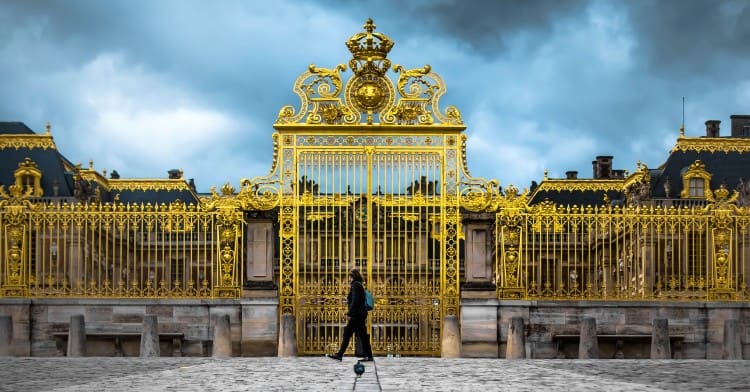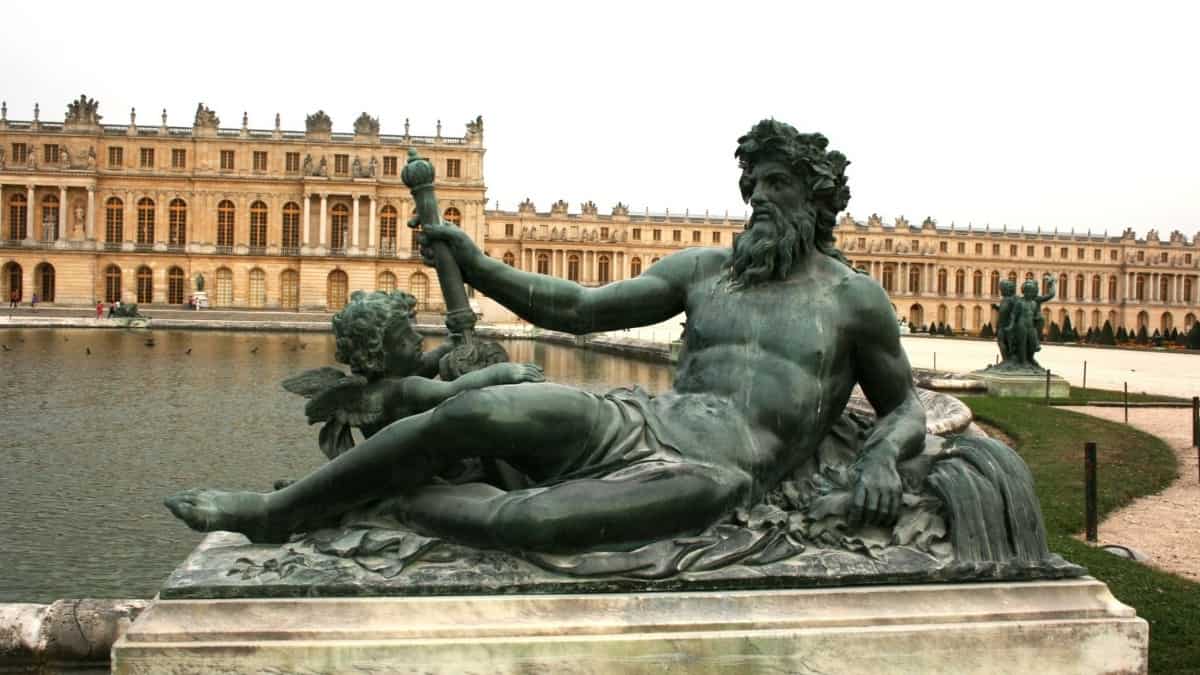
The Palace of Versailles is the World’s largest Royal domain – a space for Royals to stay.
It is 20 km (12 Miles) South-West of Paris and is a must-visit attraction for all tourists visiting France’s capital.
To say that the Palace of Versailles’ history has been chequered would be an understatement.
Considered to be one of the most outstanding achievements in French 17th century art, the Palace of Versailles is a World Heritage Site.
Louis XIII, the Sun King’s father, set the ball rolling by building a hunting lodge at Versailles.
His son Louis XIV decided to be as extravagant as possible and extended the hunting lodge.
Once the first version of the Palace of Versailles was in place in 1682, he moved his court and government to Versailles.
The French Kings ruled from this Palace for around 100 years, before the French Revolution happened, and all the Royals got kicked out (and some killed).
Table of Contents
History of Palace of Versailles
The Versailles Palace cost anywhere from 200 to 300 Billion USD to build is perhaps the costliest building ever.
It is spread over 63,154 square meters and contains 2,300 rooms.
There are lots of historical characters who contributed to the glory of the Palace of Versailles.
Continue reading to know more about the Palace of Versailles’ history –
Why Versailles?
In 1607, King Louis XIII came to Versailles on a hunting trip with his father.
He noticed that Versailles was close to Paris, was beautiful, and had a lot of game.
He visited this new-found location a few times and then, in 1623, decided to build a small hunting lodge at the site so he could spend the night.
The next year the hunting lodge was ready at Versailles.
Visual Story: 14 must-know tips before visiting Palace of Versailles
Expansion of the hunting lodge
King Louis XIII stayed at the hunting lodge for the first time in June 1624.
By 1631, the King had decided that he needed a bigger and better accommodation at Versailles and ordered the expansion.
The three-year-long construction laid the foundations for what we know today as the Palace of Versailles.
King Louis XIV finds a liking for Versailles
History suggests King Louis XIV first visited Versailles when he was only three years old – too young to remember anything.
In 1651, when he was 13 years old, he visited the Chateau built by his father in Versailles yet again.
He liked his second visit so much that he made many visits to Versailles over the next decade.
In 1661 he announced significant additions to the Chateau.
King Louis XIV starts building Palace of Versailles
Additional buildings continued to be added at Versailles until King Louis XIV died in 1715.
Some of the buildings added to what would later be known as Palace of Versailles during these 21 years were –
1. Forecourt in 1662
2. The ‘Le Vau Envelope’ in 1668-1670
3. Pavilions of the Secretaries of State in 1670-1671
4. South Wing in 1679-1681
5. Grand Commun in 1681-1684
6. North Wing in 1685-1689
7. Royal Chapel in 1699-1710
Interestingly, the King himself had donned the role of the architect for this Palace.
Hall of Mirrors is the best room at Versailles Palace.

French court and Government moves to Versailles
As the buildings started cropping up, more and more people could visit and stay at the Palace.
The King and his family conducted regular parties at this erstwhile hunting location.
In 1682, Louis XIV moved the French Court and government’s primary residence to the newly built Palace of Versailles.
Most Royals, many aristocrats, courtiers, administrators, and servants moved in to become the first occupants of this large Royal residence.
When King Louis XIV died in 1715, he had already spent 100 million Livres on the Palace.
One-third of this budget got used on the Gardens in Versailles Palace.

By this time Palace of Versailles already boasted of a 100 years long history.
Palace of Versailles undergoes a period of neglect
After King Louis XIV’s son died of illness, his grandson Louis XV became the King of France at five years of age.
The court of France decided it was better to move the seat of power to Paris.
This period was a bleak phase in the history of the Palace of Versailles.
During this period, the estate governor kept the fountains in working condition by running them once a fortnight.
Love for Palace of Versailles returns
Seven years later – in 1722 – a twelve-year-old Louis XV returned to Versailles.
Since he felt uncomfortable in massive rooms, King Louis XV built many small chambers and private rooms in the Versailles Palace.
He also completed the work on the Royal Opera House. It was also during his reign that Mozart played at this Opera house as a child prodigy.
While this King added many buildings to the Palace of Versailles, he didn’t stay there as much as his grandfather did.
Palace of Versailles gets its last King
After Louis XV’s death, his son Louis, Dauphin of France, didn’t become the King. He had a fall out with his father and hence got sidelined.
The dying King had decreed that his grandson Louis XVI should become the next King of France.
In 1770, the new King got married to Archduchess of Austria Marie-Antoinette at the Royal Opera House.
It was one of the most extraordinary events ever to take place at Versailles.
He continued the legacy of his predecessors by adding on to the Palace of Versailles. Most of his additions were inside the Versailles Palace.
Because of the costly maintenance of the Palace of Versailles and France’s wars, the King didn’t have much money for his countrymen.
During this period, there was a lot of anger against the Royals living in the Palace of Versailles.
Louis XVI would be the last King to preside over matters from the Palace of Versailles.
Attack on Palace of Versailles changed the history of France
Poverty amongst the French commoners, the high taxes imposed on them, and Marie Antoinette’s extravagant expenses made the French angry.
5 October 1789 was a defining moment in the history of the Palace of Versailles.
Thousands of women gathered in Paris’ marketplace, ransacked the armory, and then marched towards the Palace of Versailles.
Once at Versailles, the agitators broke down the Golden gate and entered the Palace.

After the initial discussions didn’t go far, the agitators compelled the king, his family, and the French Assembly to return with them to Paris.
They then beheaded the King and the Queen and sent their kids to prison.
Thus, ending the 100-yearlong dominance of the Palace of Versailles on the history of France.
Palace of Versailles after the French Revolution
Once the Royals were out of the Versailles Palace, many things happened.
The King’s Buildings service saw this as an opportunity to repair some parts of the Palace.
The French Government decided to take the paintings and furniture from the Palace and distribute it amongst the Louvre Palace Museum and Central Museum for Arts in Paris.
The Government also sold off more than 15,000 such lots of artifacts to the public.
Aristocrats, merchants, and other citizens of France bought the artifacts that the Museums didn’t want.
Many organizations started using space in the Palace. For instance, the Comédie-Francaise took over Marie-Antoinette’s former theatre.
Recommended Reading: Palace of Versailles facts
Palace of Versailles in the 19th century
The fortunes of the Palace of Versailles didn’t change much in the 19th century.
It continued to be used by various art and theatre groups, different schools, etc.
The French Government also used parts of the palace as Public Repository to store and sort items they had confiscated.
However, Versailles’ history took a turn for the good soon enough.
When Louis-Philippe became ‘King of the French’ in 1830, he didn’t wait long enough to bring Versailles to its past glory.
In 1833 he announced that he planned to transform Versailles’ Palace into a Museum dedicated to France’s glories.
After four years of hard work, the Museum got inaugurated in 1837.
Now that the Palace was back in the fold, the Royals didn’t shy away from using it.
Napoleon III received Queen Victoria in the Palace of Versailles during her 1855 visit to France.
Over the years, significant treaties got signed, and emperors got announced at the Palace of Versailles.
Palace of Versailles as of today
Millions of Euros get poured into the restoration of this historical piece of art every year.
It is one of France’s most famous National monuments and attracts more than 10 million tourists annually.
The Palace is so massive that only a small portion of it is open to tourists.
The Central part and the North and South wings of the Palace are open for tours. Rest of the Palace rooms host government offices.
So, what if we couldn’t be a part of the Palace of Versailles history? There is always the Palace of Versailles tour we can enjoy.
Today, the Palace of Versailles is one of France’s most popular tourist attractions, drawing millions of visitors every year.
The palace and its gardens have been designated a UNESCO World Heritage Site, and the palace houses several museums and galleries showcasing the art and history of France.
*BUY ONLINE TICKETS TO SAVE TIME, MONEY & ENERGY*
(Choose one from the five options given below)
>> Tickets for ONLY Palace of Versailles + Audio Guide
>> Tickets for ALL AREAS of Palace of Versailles + Audio guide
>> Tickets for Palace of Versailles + Audio Guide + Fountain Shows or Musical Gardens
>> ‘Skip the Line’ tickets for Palace of Versailles + Human Guide
>> ‘Skip the Line’ tickets for Palace of Versailles + Human Guide + Transport from Paris
